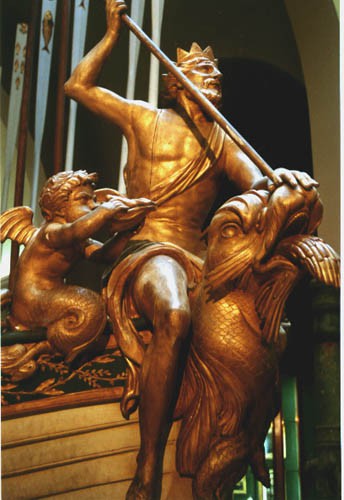The Navy Museum in Paris is one of the oldest and most prestigious
collections of its type in the world. In 1678, Colbert commissioned
the governors of the arsenals to have models made to a scale of 1/12 and 1/20
of the ships of all five classes. Some of these models were
sent to court, others were bought by individuals. One such collector,
Henri-Louis Duhamel du Monceau, inspector general of the Navy,
offered to Louis XV in 1748 his collection of model ships and military
machines. The collection was then kept in the Louvre where it was
used as a teaching aid for the students of the recently established
Ecole des ingenieurs-constructeurs (School of Engineering), founded a
few years earlier in 1741. And this was to form the basis of the Navy
Museum, itself not to be officially created until 27 December
1827 under Charles X. Today the museum is installed in the Passy
wing of the Palais de Chaillot and it contains more than 3000 models,
providing a remarkable panorama of navy history from the 17th
century to the present day. And, in addition to exhibits such as material
salvaged from shipwrecks, figure heads, navigation instruments,
uniforms, side-arms and canons and everyday objects, the museum
has a fine collection of paintings, amongst which a series of the ports
of France by Vernet.
The exhibition runs along two galleries each 170 metres long. It
begins with an evocation of the origins of navigation, before coming
to the great ships and royal galleys of the 17th and 18th centuries,
notably the Dauphine and the Grande Réale
(the sculptures from whose poop decks are quite simply breathtaking),
the Soleil Royal, the Louis XV, etc. After the French
ports by Vernet (24 were commissioned in 1752, 15 were painted and
13 are on show in the museum) and a section on the American War of
Independence, there begin the rooms given over to the Revolution and
the Empire.
Although French naval history of the Napoleonic era can be resumed
in the two battles Aboukir (Nile) and Trafalgar, it must be remembered
that this was the period when the Consulate began its policy of
renewing the French navy (with the creation of the Navy department
in the Conseil d'État and the navy prefectures) giving it a
European scale with the development of the ports and the building of
new naval dockyards on the Channel, North Sea and Italian coasts.
And at the same time as the fleet was being rebuilt in the dockyards,
crew training was improved and officer training schools were set up.
This naval policy was not to come to fruition during the Empire but
was rather to be enjoyed by the regimes which came later.
In 1814, the fleet was made up of 73 vessels in service and 31 under
construction, and the models of many of these ships are held in the
museum. As well as vessels from the flotilla from Boulogne which
was to invade England, there is the L'Océan, a vessel of
the first class with 118 canons, La Muiron, a 44-gun frigate,
L'Achille, a 74-gunner built in Rochefort in 1802, Le
Friedland, a second class vessel with 80 canons built in Antwerp
between 1807 and 1810, Le Rivoli, 74-gunner built in 1812 in
Venice, etc. But the pièce de résistance in this
section is the Emperor's Launch (not a model this time!) built in 1810
in the record time of 21 days following plans by Chapmamet and
Guillemard and decorated by Van Petersen (see above the figure-
head). Seventeen metres long, this launch carried Napoleon and
Marie-Louise during their visit to the mouth of the Escaut and the
construction work on the docks in Antwerp, 30 April, 1810.
Requisitioned by Louis XVIII and transported to Brest, it was altered
on the occasion of Napoleon III's and Eugénie's visit to the
town in 1858.
There are in addition many other items from the First Empire, notably
the touching models of ships (in wood, bone or straw) made by French
prisoners of war held by the English and the famous Dieppe ivory
miniatures. There is a model of La Belle Poule (the ship that
brought back Napoleon's ashes from St Helena), a wooden gilt eagle
which formed part of the Emperor's mortuary chapel, brass nails from
La Belle Poule's hull, memorabilia belonging to the Prince de
Joinville in a cabinet by Jacob forming an commemorative ensemble
relating to the return of Napoleon's ashes.
In the first gallery there are only a few paintings relating to
the Second Empire, by Morel-Fatio and Gudin. It is only in the second gallery
that the history of the modern navy begins. Models of the frigates
L'Isly (1849) and L'Audacieuse (1856) relate the
arrival of steam power. In fact the Second Empire was a glorious
period for the French Navy as a result of the intelligent policy of
Napoleon III – he considered the navy the principal tool of French infl
Musée de la Marine, Paris


